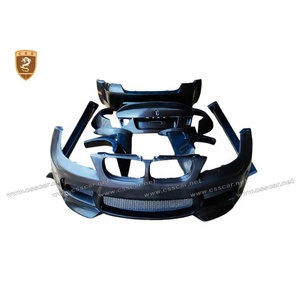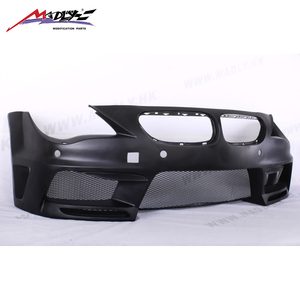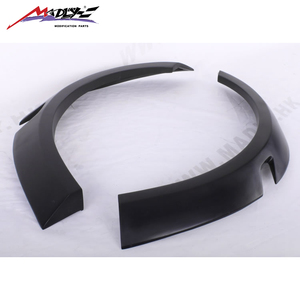Bmw 6 series body kit
(4474 products available)






Factory Carbon ABS+PP Body Kit BMW 6 Series F06 F12 F13 New Condition Model Car Upgrade Modification Repair Front Bumper Grill







Car Conversion Facelift Bumper for BMW F30 F32 G20 G22 Upgrade to G80 M3 G82 M4 LOOK 1:1 Widebody Bodykit F30 to G80 Bodykit








For Bmw F30 M3 Bodykit 3 Series Tuning Pp Front Bumper Side Skirts Front Fenders Body Kit








Body Kit for BMW 4 Series F32 Upgrade to M4 Style Front Rear Bumper Side Skirts Car Hood M4 Type Bumper








Oem Dry Carbon Fiber BodyKit Front Bumper For BMW M2C/M2 F87 2014-2022 Front Bumper








M3 Style Wide Body Kit for BMW F30 M3 Body Kit 2013-2018 Car Bumpers Side Skirts Fender Grille bmw F30 Wide Bodykit F30 Bodykit







Carbon Fiber Bumper Body Kit for BMW F90 M5 2018-2019 MP Style Grill Front Lip Mirror Cover Splitter Side Skirt Diffuser







For BMW 5 Series F10 Upgrade G30 LCI M5 Body Kit with Front Bumper Headlights Hood Rear Bumper Fender Car Upgrade Parts







XLstyling Car Facelift Conversion Body Kits for BMW 3 Series E36 1990-1998 M3 Front Bumper
Popular in your industry







Xlstyling M3 Facelift Body Kit Rear Diffuser Front Grille Rear Bumper for BMW 3 Series E36







Auto Carbon Fiber Body Kit Rear Diffuser for BMW 3 Series Pre G20 Kbl Type Rear Diffuser 2019-2022
Related Searches:







2025 New VRS Front Lip Splitter pp Carbon Fiber Spoiler for BMW M3 G80 M4 G82 2021 2022 2024 Body Kit Tuning Accessory Car Parts







M6 Body Kit Front Rear Bumper Side Skirts for BMW 6 Series F06 F12 F13 640I 650I Upgrade M6 Body Kit Full Set







Genuine Body Kits for BMW F06 F12 F16 6 Series 640i 650i Facelift M6 Front Car Bumpers Side Skirts Fenders Rear Bumper Diffuser







High Quality Body Kit for Auto Car Parts M2 Style for 2 Series F22 F23 M2 Bumper Body Kits







High Quality M3 Look Front Bumper Kit for BMW E30 '82-'90 ABS Plastic Carbon Fiber Body Kit with Excellent Protection







F06 F12 F13 to PD Style Body Kit for BMW 6 Series 640i 650i Gran Coupe Front Rear Bumper Fender Side Skirts FRP Hood Bodykit







PP Body Kits Front Bumper Rear Bumper for BMW 3 Series E90 2006 2007 2008 2009 2010 2011 2012







For BMW 5 Series I5 G60 G68 530Li 2024+ High Quality MP Style Real Carbon Fiber Front Lip Bumper Splitter Car Body Kits






PD Style Body Kit for Bmw Series 7 F01 F02 Front Bumper Lip Rear Diffuser Side Skirts Car Body Kit






FLDZ Auto Parts Front Bumper Lip Rear Bumper Rear Spoilers Car Body Kit for Bmw E36 M3 Style Look Body Kit






AMP-Z E60 Auto Body Modification Kits Front Lip for BMW 5 Series E60 E61 M5 Sport 2005-2010 Gloss Black Car Accessories







amber Body Kits for BMW 6 Series E71 2007-2015 Upgrade to 2024 G06 LCI X6M F96 High Quality Bumper Led Headlight Grill Car Accessories






Auto Parts for BMW 6 Series M6 F12F13 Body Kit M6 F12 F13 Upgrade MB Style Wide Body Kit







AMP-Z Wholesale Body Kit ABS Carbon Fiber Rear Trunk Roof Wing Spoiler for BMW 1 Series E87 E81 2004-2011







1991-1998 RB STYLE FRP GLASS FIBER WIDE BODY KITS for BMW 3 SERIES E36







Manufactory Direct Auto Body Kit for BMW 3 Series G28 2019-2022 Front Bumper Assembly With Headlight & Radiator Set







Auto Facelift Refit Body Kit for BMW 2 Series F22 F23 2014-2022 Update to Racing M2C M-Power F87 Widebody Style with Fender







Vorsteine Style Wide Body Kit Fit for BMW E90 3 Series Car Accessories Body Kit Factory Price







Runde for BMW 3 Series G28 G20 Upgrade CMST Style Dry Carbon Fiber Material Body Kit Front Lip Side Skirts Rear Diffuser Spoiler







Carbon Fiber Rear Bumper Lip Diffuser Spoiler Body Kits for BMW 6 Series F06 F12 F13 M6 M Tech M Sport 2013-2016







Wholesale Unpainted 5 Series Refit Front Bumper Rear Bumper E39 M5 Full Part Body Kit Bodi Full Kit for BMW






Hot Sale FRP Material P Style Wide Body Kit with Hood Fender Flares for BMW 6 Series F06 F12 F13 2011-2017






G30 to F90 M5 Body Kit for BMW 5 Series G30 Modified to F90 M5 Body Kit Car Bumper Grille Side Skirts Parts







High Performance Car Body Kits Front Rear Bumper for BMW 7 Series F02 G11 G12 Upgrade to New Widebody Body Kits
Top categories
About bmw 6 series body kit
Types of BMW 6 Series body kit
BMW 6 Series body kits are cosmetic modifications applied to the exterior of a car. These modifications are made to help the car stand out and give it a sportier look. A body kit is made up of several parts, such as spoilers, modified fenders, and side skirts, which are typically installed on the car's exterior. They are designed to enhance the aesthetics of the vehicle and, in some cases, improve its aerodynamic performance.
The front body kit is an aesthetic enhancement that is fitted in the front of the car. It is divided into several sub-parts, which include:
- The front lip spoiler: It is the part of the body kit that is attached to the lowest edge of the front bumper. Its primary role is to enhance the vehicle's appearance and improve its aerodynamic performance.
- The front bumper: It is the part of the car that is located at the front and is designed to withstand minor crashes. It is located between the front wheels. The front bumper is used to modify the aesthetics of the front part of the car.
- The front fender: It is the part of the car that is fixed over the front wheels. Its major role is to stop debris from being thrown into the air by rotating tires, protecting the vehicle and pedestrians.
The side body kit is a visual upgrade fitted on the lower part of the car. It is divided into the following sub-parts:
- Side skirts: These are panels installed under the body of the car between the front and rear wheels. Their primary role is to improve the aesthetics of the car.
- The rear bumper: This is the portion of the car located at the back. It is designed to endure minor accidents and is located between the rear wheels. It is used to modify the vehicle's aesthetics.
- The rear diffuser: This component of the body kit is fitted to the base of the rear bumper. It helps in the management of airflow and is used to upgrade the vehicle's aesthetics.
Specifications and Maintenance of BMW 6 Series Body Kit
BMW 6i body kit are designed to make BMW vehicles more aggressive and unique. Here are specifications for the body kit and maintenance tips.
- Specifications
Material: The BMW 6 series body kit is made with different materials. The common ones are carbon fiber and polyurethane. Carbon fiber material is used in motorsports. It is light and durable. This material gives the vehicle a sporty look. The carbon fiber body kit is more expensive than the polyurethane kit. Polyurethane is a flexible material that is resistant to damage. It is also affordable. The body kit is available in ABS plastic.
Components: The BMW 6 body kit has several components. It has a front bumper, which is the most noticeable part. The front bumper is designed with air vents, and its shape is more aggressive than the standard one. The body kit has a rear bumper that is wider and more stylish than the standard one. The kit also includes side skirts, which are placed between the front and rear wheels. The side skirts give the vehicle a low profile look. The body kit has a rear spoiler, which is mounted on the rear trunk. The spoiler improves the vehicle's aerodynamics. Some body kits may have additional components like canards and diffusers.
Fitment: The BMW 6 series e63 body kits are designed to fit on different models and years. Examples of BMW models that the body kit fits are the 6 Series F12, E63, and F13. Manufacturers of body kits specify the BMW models and years that their body kit fits. This ensures that the body kit has a perfect fit, and the installation is easier.
- Maintenance
Car owners can maintain the BMW 650i body kit by following these tips.
Regular Cleaning: Car owners should clean the body kit weekly. They should remove dirt, dust, and debris that have accumulated on the surface. Car owners should use a soft cloth, sponge, and mild detergent to clean the body kit. They should avoid using harsh chemicals.
Inspect the Body Kit: Car owners should inspect the body kit for cracks, chips, or damage. In case of damage, car owners should repair or replace the body kit. They can contact a professional mechanic for assistance.
Avoid Harsh Chemicals: Car owners should avoid using harsh chemicals on the body kit. Examples of harsh chemicals are acetone and bleach. The chemicals can cause discoloration and damage to the body kit material.
Protect From Sunlight: Carbon fiber body kit is prone to damage from sunlight. Therefore, car owners should park their vehicles in the shade. They can also use a car cover to protect the body kit from sunlight.
Tighten Fasteners: Car owners should check the body kit for loose screws, bolts, or fasteners. They should tighten the fasteners using appropriate tools. Tightening the fasteners prevents the body kit components from falling off the vehicle.
Above are specifications and maintenance tips for BMW 6 Series car body kits. The car body kit enhances the appearance of the car and makes it unique.
How to choose a BMW 6 Series body kit
- Fitment
- Material
- Style
- Budget
- Brand
One of the first things to consider is the fitment of the body kit. As mentioned earlier, the purpose of the body kit is to enhance the aesthetics and performance of the vehicle. Therefore, it is important that the body kit be perfectly installed in order to achieve the desired effect. It is advisable to select a body kit that is specifically designed for the model and year of one's vehicle. If the vehicle is a BMW 6 Series, be sure to select a BMW 6 Series body kit. This will ensure that the body kit fits perfectly into the vehicle's structure, making installation easier. The body parts are also likely to line up and match the original body lines of the vehicle. This gives the vehicle a stylish look.
Another important factor to consider is the material used to make the body kit. The material determines the durability of the body kit. A body kit is often exposed to the external environment. Thus, it is subject to wear and tear from elements such as sun exposure, rain, and road debris. One should select a body kit made from durable materials that can withstand these conditions. A popular choice is a body kit made from polyurethane or polypropylene material. These materials are flexible and resistant to impact. They are less likely to crack or break when the vehicle drives over rough roads. Additionally, the body kit may be composed of carbon or fiberglass. These materials are lighter in weight and have good aesthetics. However, they are more fragile and may be more prone to damage.
When choosing a body kit, one should consider the styling of the vehicle. The body kit is designed to enhance the aesthetics of the vehicle and give it a personal touch. There are various styles for body kits, including aggressive, subtle, and elegant. One should select a body kit that complements the existing styling of the vehicle. The body kit should also reflect one's personal style preferences. For example, if one prefers a sporty look, a more aggressive body kit with large air intakes and sharp lines would be suitable.
As with any purchase, one should consider the budget for the body kit. Body kits are available in different price ranges. Kits made from more advanced materials such as carbon fiber may be more expensive. One should consider the features and benefits of different body kits and choose one that fits within the budget.
When selecting a body kit, one should consider the brand. It is advisable to choose a reputable brand that is known for quality body kits. Additionally, one can read reviews from other buyers to get an idea of the quality of the body kit.
How to DIY and replace BMW 6 Series body kit
Changing a body kit can be a challenging project. However, it can be done with the right tools. Here's how to replace a BMW 6 Series body kit step by step.
- Gather the right tools and materials: The tools needed for the job include screwdrivers, trim removal tools, a heat gun, and a torque wrench. It is also a good idea to have safety gloves and eye protection.
- Remove the old body kit: Use a screwdriver and trim removal tool to take off any mud flaps, trim pieces, and other accessories. Then, use a heat gun to soften the adhesive of any decals or trim pieces. Gently pry them off to avoid damaging the paint. Next, unscrew the bolts that hold the old body kit in place. Use a torque wrench for this step to ensure the right level of force is applied.
- Prepare the vehicle: Clean the area where the new body kit will be installed. This provides a clean surface for the new adhesive to stick to.
- Install the new body kit: Start by attaching any spoilers or trim pieces with bolts. Then, apply adhesive to parts like side skirts and press them into place. Be sure to follow the manufacturer's instructions for the type of adhesive used. Once everything is installed, wipe down the new body kit with a clean, dry cloth.
- Reinstall accessories: Once the new body kit is in place, reattach any accessories that were removed, such as mud flaps or trim pieces.
- Test drive the vehicle: Before taking the car out on the road, check to ensure all parts are securely in place. It is also essential to test drive the vehicle and listen for any unusual sounds or vibrations that may indicate loose parts.
Q and A
Q1: What is the difference between a body kit and a regular car?
A1: A body kit is often used to enhance the look of a car, while a regular car is just a car with no modifications.
Q2: Will any body kit fit a BMW 6 series?
A2: No, only a body kit designed for a particular car will fit perfectly.
Q3: How often should the BMW 6 series be serviced?
A3: The frequency of servicing varies among the models. However, most of them are serviced at 12 months or after every 12,000 miles. The older models may require servicing after every 6,000 miles.





















































 浙公网安备 33010002000092号
浙公网安备 33010002000092号 浙B2-20120091-4
浙B2-20120091-4